Need lots of power?! Most large motorhomes like ours have a 50-amp RV generator built-in from the factory. But many folks buy older Class A motorhomes, some of which may never have had a built-in generator. And others may have generators that were not well maintained and have suffered extensive or even permanent damage.
More commonly, there are lots of 50-amp travel trailers and fifth wheels that don’t have built-in generators at all.
All of these travelers make up a group of RVers who may look to supplement their onboard power system with a portable 50-amp RV generator. So, today we’re investigating the best generators for a 50-amp RV.
What is 50-amp Power?
First, it’s important to understand that 50-amp power, as supplied at a campground pedestal, is split-phase. That means that there are two AC “hot” lines, each delivering 120 volts of AC power which are out of phase from each other by 180 degrees (when measured with respect to the neutral, while measuring across the two hot legs would show 240V AC), along with a common neutral wire and a ground wire.
What does it mean to have power that’s 180 degrees out of phase? Good question! Remember, the “AC” part of “120V AC” power stands for “Alternating Current.” The power coming from the outlets in your house is sine-wave power – voltage cycles from +120V to -120V and back again in a steady curve called a sine wave that looks like this:
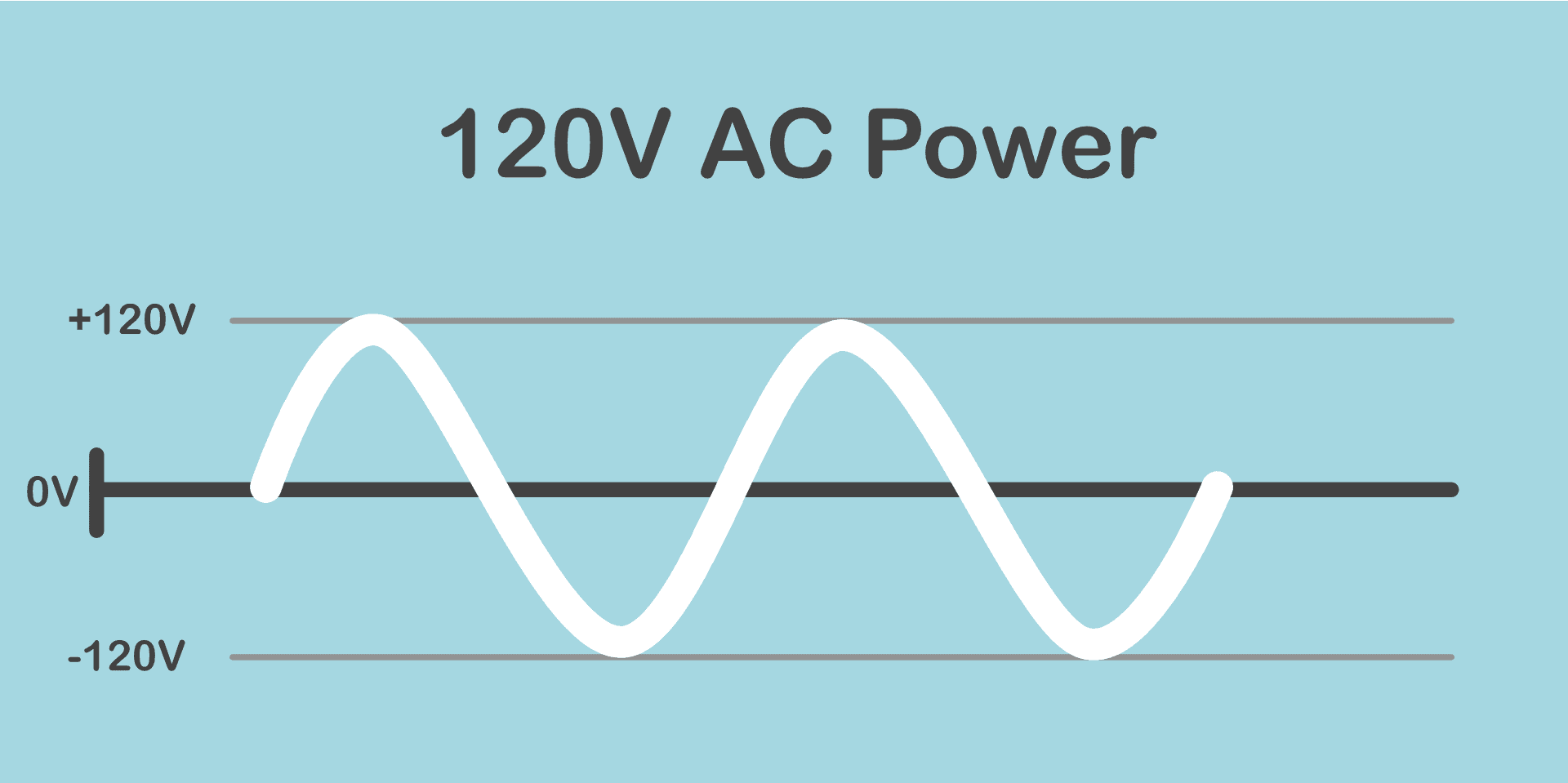
A graph of 120V AC power, showing the voltage cycling (smoothly) from +120V to -120V
If you have two legs of 120V power, they could be “in phase” or “out of phase.” If they’re “in phase” with one another, it means they cycle from +120V to -120V and back again… at the same time… in the same frequency.
If they’re “out of phase,” it means they aren’t at the same voltage at the same time, and the number of degrees out of phase they are is a measure of how far off that cycling is, with 180-degrees being the halfway point where one line/leg will be at +120V, and the other will be at -120V at the same time. So measuring the voltage across those two lines/legs, your voltmeter would show a difference of 240V, which would look like this:
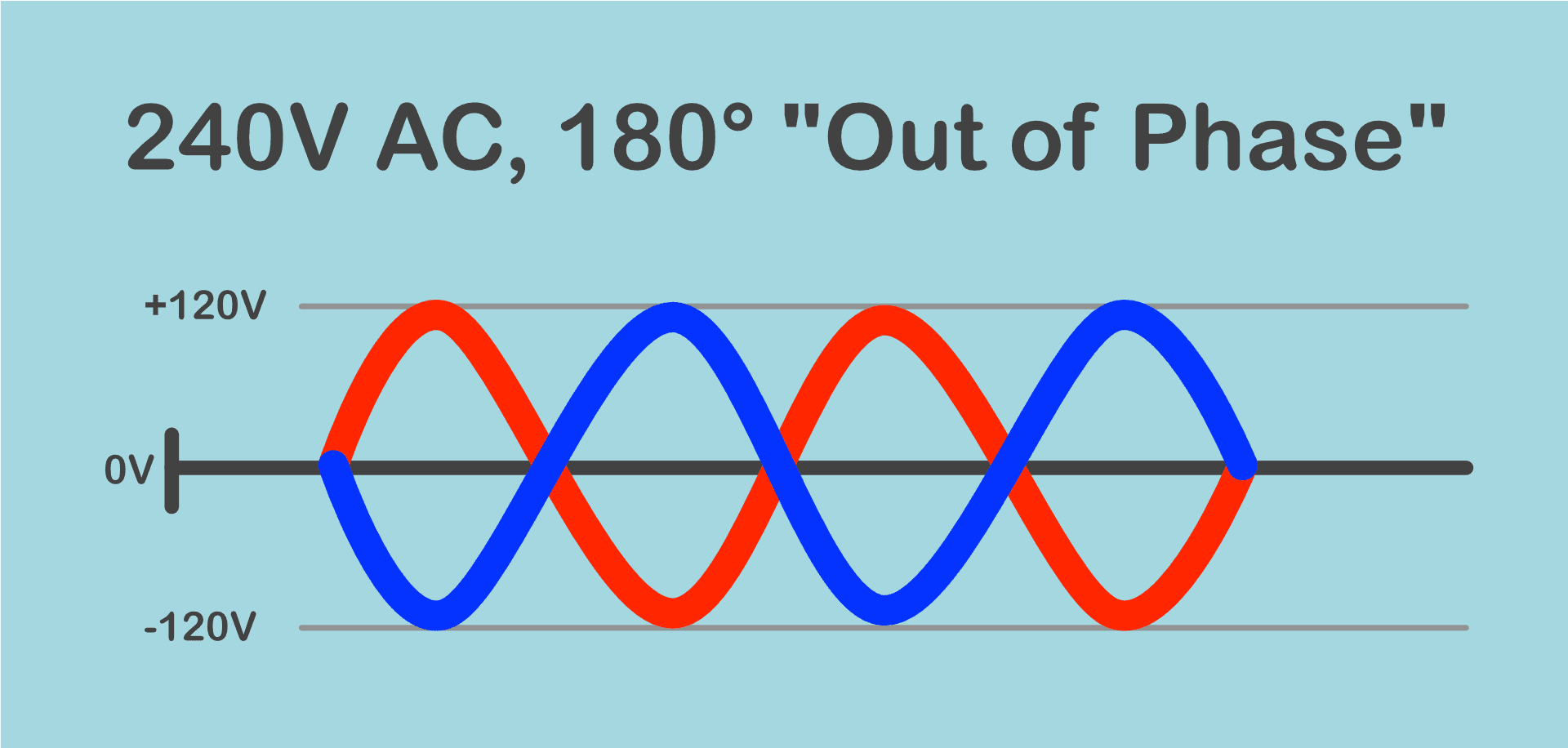
Graph showing two legs of 120V AC power that are 180-degrees out of phase with each other. At their peak + or – voltage, the difference measured between them is 240V.
50-amp RVs are typically wired to utilize each 120V AC line supplied at the pedestal to power a portion of the outlets/appliances onboard. So, half of your RV’s 120V AC electrical devices usually run from the power supplied by one 120V, 50A leg of the outlet. And the other half of your RV uses the other 120V, 50A leg.
So, a 50-amp circuit can supply 50 amps at 240V, which is 12,000 Watts (Watts = amps x volts, so 50A x 240V = 12,000W). But your 120V, 50-amp RV will really be using the power as 100Amps (2 x 50A legs) at 120V. That’s the same 12,000W (100A x 120V = 12,000W), just split up a little differently.
But most smaller generators are only single phase, not split-phase. That means that they can only supply a single 120V AC leg, not two separate 120V legs. Generally, these generators are limited in the amount of power they can provide, often maxing out at 30-amps (or 3,600 Watts).
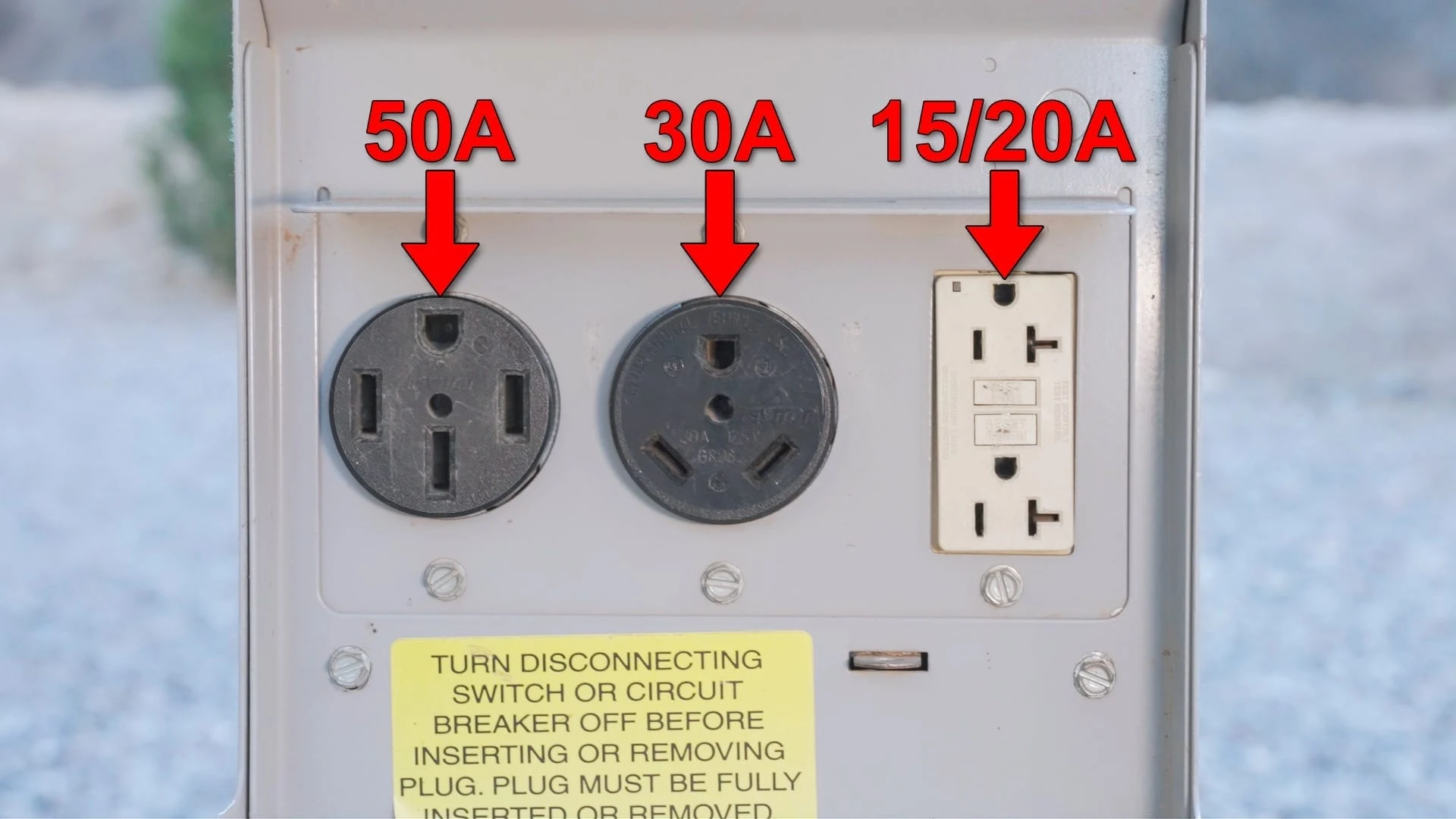
From left to right: 50-amp, 30-amp, and 15/20-amp connections at a power pedestal.
It’s important to know this fact because if you’re looking for a true 50-amp RV generator, you’ll need one that’s capable of supplying two separate legs of 120V AC power, often listing them as being 120/240-volt generators.
IMPORTANT NOTE:
A split-phase, portable generator would be able to provide 240V power. Using a 50-amp outlet doesn’t pose any problems, as it’s your RV’s wiring arrangement that utilizes that power correctly. But if the generator also has a 30-amp outlet, be sure you know if it’s supplying 120V or 240V to that receptacle. 120V is safe, but 240V power would do severe damage to the electrical circuits and appliances onboard your RV.
What to Look for in a 50-Amp RV Generator
There are several considerations to be aware of when shopping for a 50-amp RV generator.
Wattage
Built-in RV generators commonly have anywhere from 2,500- to 8,000-watt power ratings, though some can be as large as 12,000 watts. For example, the built-in generator on our 43-foot 2005 Newmar Mountain Aire diesel pusher is an Onan 7.5kW QuietDiesel generator.
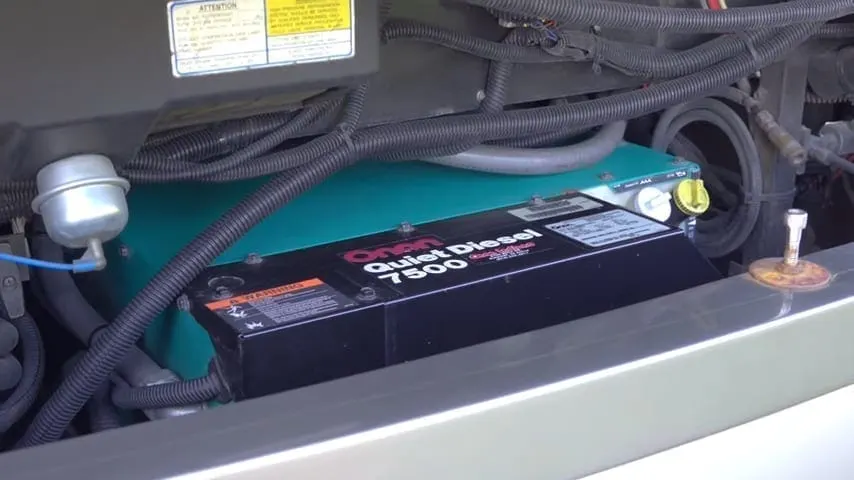
A photo of the Onan 7.5kW QuietDiesel generator in our 2005 Newmar Mountain Aire diesel pusher.
The amount of power that a generator can produce is rated in watts. So, using our generator as an example, our Onan has a maximum power output of 7,500 watts.
When shopping for a 50-amp RV generator, you’ll want to look for a generator that’s capable of producing sufficient power for your needs. Plus, you always want to leave a margin of safety, and remember that a generator shouldn’t run at full load for extended periods (as a rule of thumb, no longer than 30 minutes at maximum power output).
With that in mind, add up all of the estimated wattages for the appliances, devices, and tools that you’ll be operating at the same time. Then, buy a generator that is larger than the total number you’ve estimated (bear in mind that it’s less costly to buy a higher wattage generator than to have to buy a second generator or be forced to upgrade later). Also, remember that you can reduce your need for a larger generator by managing your power consumption (don’t microwave dinner while running both air conditioners, for example).
A generator’s rated, continuous (or running) power output is typically 90% of its maximum power and is a more reliable measure of the genny’s ability because it refers to the amount of power a generator can produce for an extended period of time.
Be sure to watch for SURGE, PEAK, or STARTUP wattage ratings vs. CONTINOUS or RUNNING wattage.
Additionally, the appliances you want to run in your RV will consume more power on startup (surge) than they will when they’re running (continuous).
Manufacturers like to quote surge wattage ratings for their generators because they’re higher numbers. However, it’s incumbent upon you as the buyer to make sure the generator can sustain a high-enough wattage output to run all the appliances and devices you need to run for as long as you need to run them.
Quite frequently, one of the most influential factors in determining the necessary wattage of a 50-amp RV generator is whether you have one or two air conditioning units on your rig and whether you’ll be using them both at the same time.
PRO TIP — The most common dividing line between 30-amp and 50-amp RVs is the number of air conditioners. A rig that’s large enough to require 50-amp service is also large enough to need 2 or 3 air conditioners. So when you see an RV with one A/C unit on the roof, it’s probably a 30-amp rig. On the other hand, if an RV has two or more A/C units, it almost certainly has 50-amp electrical service.
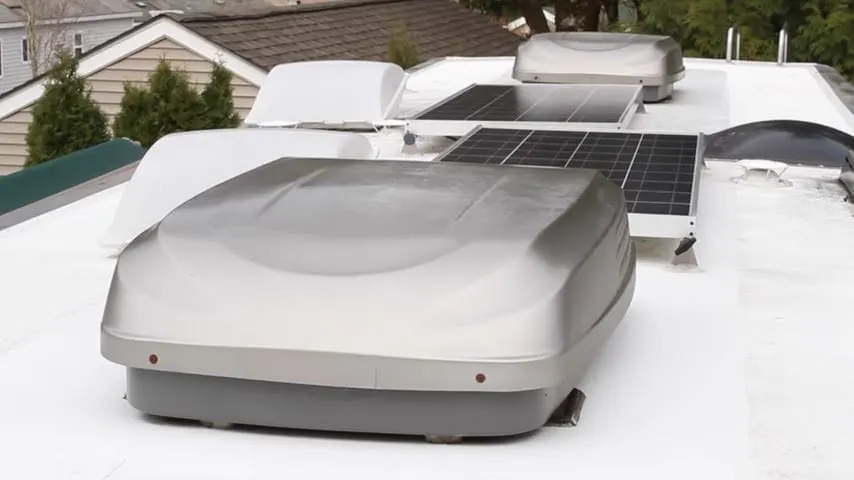
We have two heat pump/air conditioning units on our 43-foot motorhome. We installed a Micro-Air EasyStart in each of them to enable the units to start/surge at lower wattages.
For example, an RV with one 15,000 BTU air conditioning unit will often require no larger than a 4,000-watt generator. But, adding a second 15,000 BTU AC unit increases your startup or surge wattage requirements substantially. Here’s why:
Smaller air conditioning units require lower startup and running wattage, but many 50-amp RVs have multiple 15,000 BTU air conditioning units. A 15,000 BTU air conditioner will generally have a starting/surge wattage of 3,500 watts (but a continuous/running wattage of only 1,500 watts). So, if you’re going to run both AC units at once, your surge/startup wattage will substantially exceed 4,500 watts, and you’ll certainly need to look for a 7,500-watt or larger generator (though you can look into installing a Micro-Air EasyStart in each A/C unit, like we did, to reduce the startup amperage requirements of your air conditioners so they can both run off a smaller generator).
Try to remember that there’s usually no need to run everything that requires power in your RV at once. For example, you probably don’t need to run two air conditioners, your microwave, an electric coffee pot, your blow dryer, your dishwasher, and your washer & dryer all at the same time (and probably shouldn’t!). Calculate your needs carefully before selecting a generator capable of a particular maximum output with that in mind.
Size/Weight
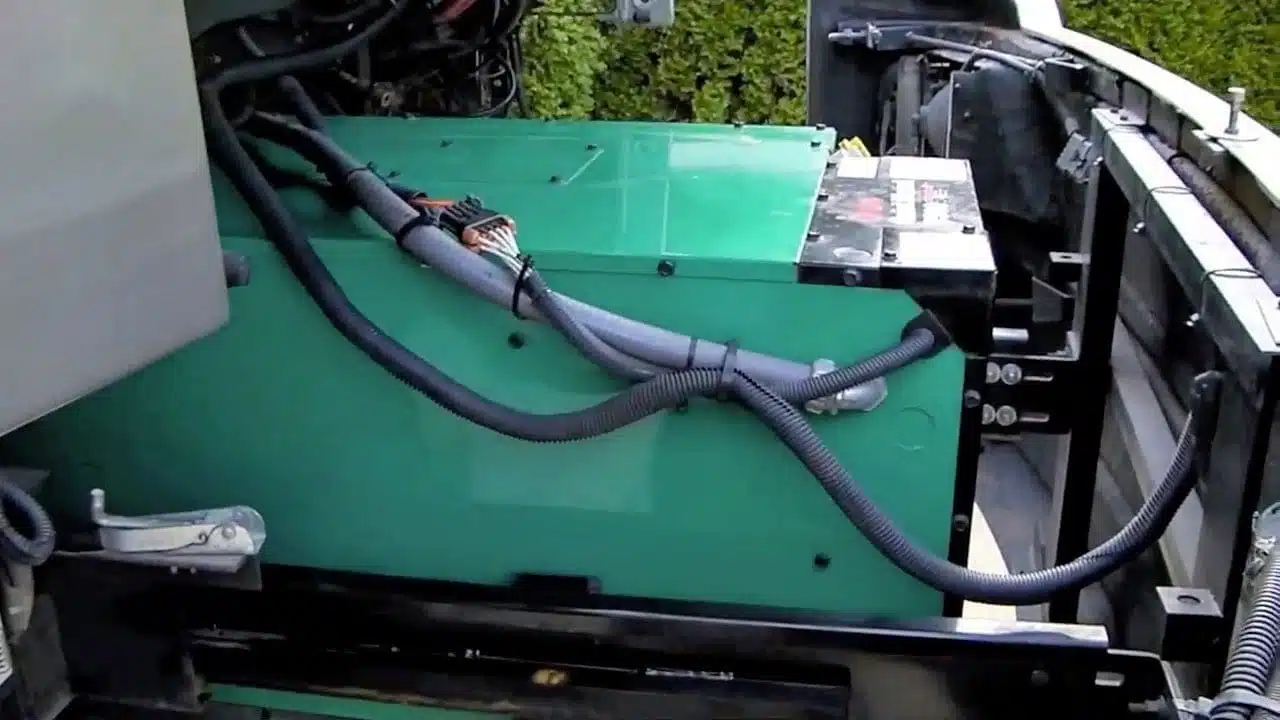
Our built-in 50-amp, 7,500-watt RV generator is large and very heavy. Portable 50-amp generators are large and heavy as well.
As always, size and weight are considerations for every RVer, and a 50-amp RV generator is likely to be among the heaviest items you add to your RV. Therefore, taking the size and weight of the generator into consideration is important, while still making sure it will provide the power you need.
Knowing where in your RV or tow vehicle you’re going to store your generator, as well as how mobile you’ll need it to be, are essential considerations. Remember, you can’t run your portable generator everywhere: generator exhaust (and noise) need to be considered. So you’ll likely need to be able to move the generator you buy in one way or another (unless you’re buying a built-in 50-amp RV generator and having it installed in an RV bay that allows for external exhaust).
Some generators are encased in a structure that’s on wheels for easier mobility. Even so, you may need to lift and move the generator, and you’ll need to consider its weight when deciding which unit to purchase. And it shouldn’t be surprising that 50-amp generators, which produce more power than smaller units, are both heavier and larger. This might make “portable” a somewhat dubious term for many RVers.
Price
Budget is usually a consideration for most of us, so determining how much you’re comfortable spending on your 50-amp RV generator is a smart move. Along with wattage, size, and weight, price will factor in and will guide you to the choice that’s the best fit for you.
Noise Level
Generators are pretty noisy. All of them. Even the generators (like ours) that use “quiet” technology are not truly quiet. However, some generators are far louder than others, and most have a decibel rating that you can check as you shop.
Many generators have decibel ratings between 55 and 70 when running, and some run at their quietest only in Eco-mode, usually at a 25% to 50% load. So, it’s likely that the generator you buy will make more noise than its decibel rating advertises when operating at 100% capacity, or even anywhere over 50%.
If you happen to know someone with a generator of the same wattage you’re seeking, ask if they’d be willing to power it up to let you hear it running. Actually hearing a generator running is the best way to understand in advance what the noise level of that unit will be.
No matter what anyone tells you, no matter if reviewers refer to a generator as “quiet”, no matter if marketing and advertising forces shout from the hills that it’s a quiet generator, we think that all generators are noisy, so anticipate this upfront.
All that said, there’s no sense in buying a generator you can’t use because it’s so loud that neither you nor your neighbors can tolerate the noise.
Of course, one of the big advantages of a portable generator like this is that you can move it away from the RV (and your neighbors) to help minimize the noise. Just be sure to use a properly-rated extension cord to connect your RV to it.
Fuel Intake/Usage
RV generators will run on either propane, diesel, or gasoline. There are also dual-fuel generators that can run on either gasoline or propane.
When you have a built-in RV generator, it typically runs on the same fuel the RV’s engine uses. So, for example, we have a diesel pusher, and our Onan generator runs on diesel fuel. That allows us to use the same fuel tank to run both the engine and the genny (convenient, since our onboard fuel tank is 150 gallons).
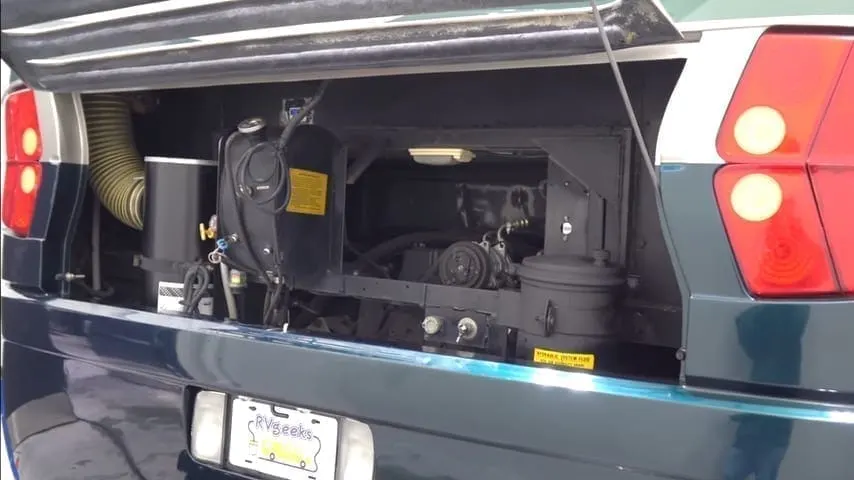
Our Newmar Mountain Aire has a diesel engine and a built-in Onan diesel generator.
Buying a generator that uses the same type of fuel as your rig makes sense, allowing you to keep just one type of fuel on hand. Many portable RV generators run on gasoline which is a bit more widely available than diesel and propane.
You’ll also want to consider how much fuel the generator burns when powering various appliances. This information should be offered in the marketing literature. However you’ll want to make sure to understand the capacity at which the generator is running to get a better idea of the stated fuel consumption.
For example, a generator’s specs may say that it will run for 18 hours on a full tank of fuel. But it’s also important to know that this statement generally refers to 18 hours running at 25% of its total load capacity (that’s actually relatively fuel-efficient, by the way – but you must have a clear understanding of the capacity at which a genny is running for the stated number of hours on a tank of fuel).
So, as always, read the fine print and make sure you know what you’re getting before you buy.
Inverter Generators
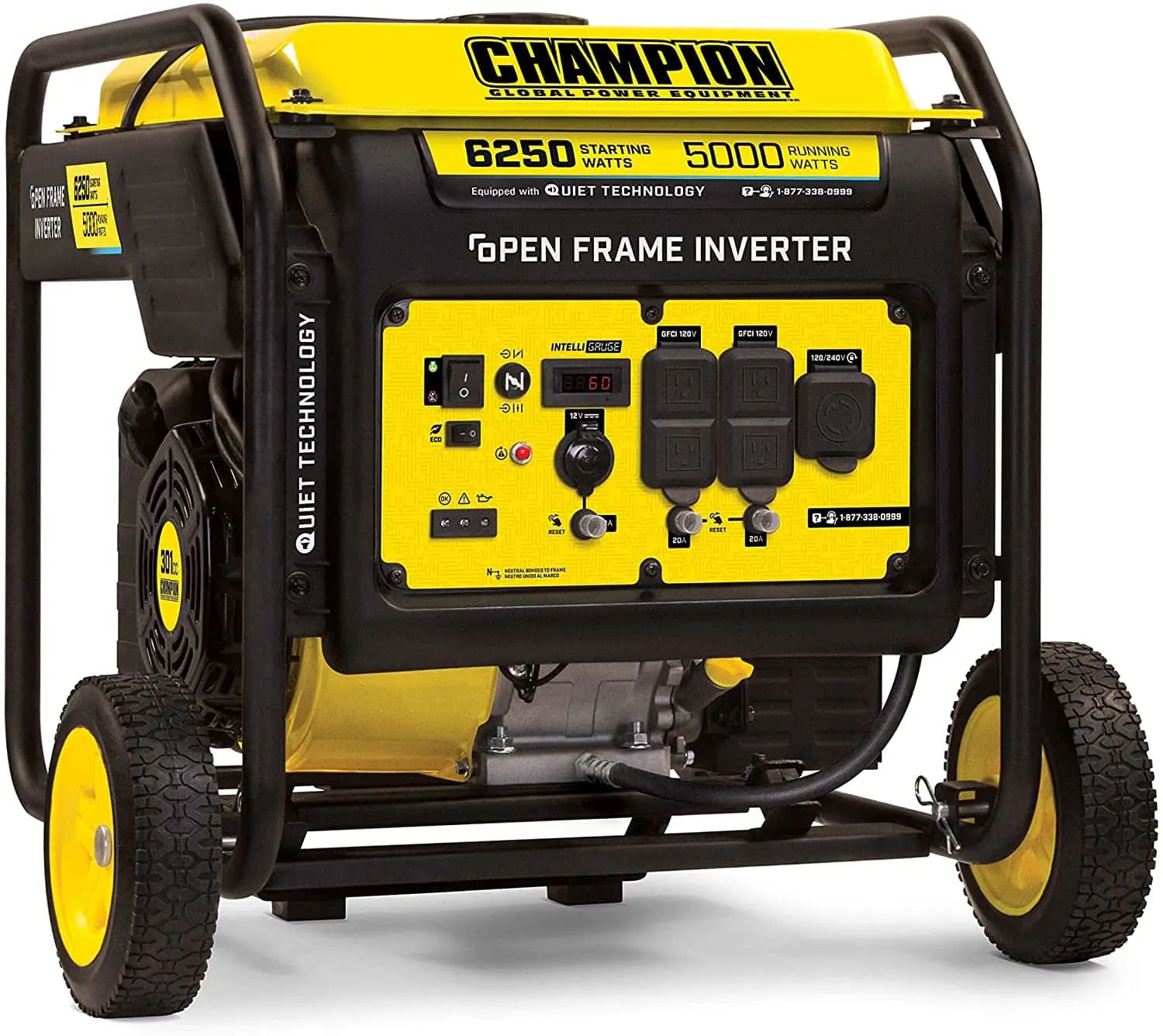
Inverter generators are usually quieter, smaller, lighter, and more efficient than standard generators.
Smaller, lighter, and quieter than standard generators, inverter generators utilize a DC generator to supply the power and have a built-in inverter to change that DC power into 120V AC power. This setup allows them to be very efficient. By utilizing the inverter to supply a steady 120V AC output, they can change the DC generator’s speed, running at slower (more fuel-efficient & quieter) speeds for lighter loads, then ramping the speed of the motor as demand increases.
Non-inverter, standard generators typically operate at a constant, non-adjustable speed, which means they have a continuous noise level, fuel consumption, and exhaust output.
So, inverter generators are quieter, more fuel-efficient, and more environmentally friendly. But all of this comes at a cost. Inverter generators are often twice as expensive as a standard generator of comparable power output. And they aren’t generally available with the large outputs we’re looking for in a 50-amp rig.
Some of the Best Portable Generators for a 50-Amp RV
Here are a few of the best 50-amp RV generators and why we like what they offer. Below is certainly not an exclusive or exhaustive list – but these are good units with good reasons to consider them.
Champion 100813 9375/7500 Watt Generator
- Ultra-Powerful: At 9375 starting watts and 7500 running watts, enjoy up to 8 hours of run time on a full tank of gasoline with a noise level of 74 dBA...
- Electric start: Trust the reliable 420cc Champion engine with its battery-included electric start featuring a reliable toggle switch, plus built-in...
Champion has been a manufacturer of generators for many years and makes many different models. This particular unit is a 7.5KW generator (the same as ours) with a 420cc Champion engine.
This is a highly versatile generator with multiple outlets that preclude the need for various dog-bone electrical adapters.
Pros: This genny is rated at 7,500 running watts (note that we said “running” – not surge or startup), and it has a time-tested engine. We also like this unit’s electric start (battery included), making it easier to get running when needed.
Our friends in Canada, and those of you in cold climates in the US, will appreciate its built-in cold start technology, which allows easy starting in cold weather.
We like the versatility of this generator: it has four covered outlets, including multiple 120V 20A GFCI outlets, a 120/240V 30A outlet, and a 120/240V 50A outlet. This unit also has a built-in surge protector to prevent overloads, keeping your RV and appliances safe.
This 50-amp RV generator uses what Champion calls “Intelligauge,” allowing you to monitor voltage, hertz, and run-time hours. This is helpful for power monitoring, as well as keeping track of the need for regular maintenance.
And finally, Champion’s support includes a 3-year limited warranty as well as free lifetime tech support.
Cons: This generator is heavy, weighing nearly 200 lbs., and relatively large at 29.9 x 27.2 x 25.2 inches. It’s also somewhat loud, rated at 74 dBA from 23 feet.
Best For: situations that are unlikely to call for the unit to be moved with any frequency at all. It’s on rugged wheels for easy movement on level solid ground, but 200 pounds is a lot to lift off an RV/truck, even infrequently.
Durostar DS10000E Portable Generator
- POWERFUL DUROSTAR ENGINE: The DS10000E is Powered by a 18HP 440cc OHV Durostar Engine.
- Powerful Engine – The DuroStar 439cc OHV engine is a workhorse that provides plenty of power to handle multiple jobs, from powering high voltage...
Durostar’s DC10000E is a gas-powered portable generator with 10,000 peak watts and 8,000 running watts. In addition, this unit has an electric start and all copper windings, which can translate to more power and a longer lifespan.
Pros: The 440cc OHV engine is robust and powerful, promising a long & trouble-free life. The “MX2 Technology” allows you to choose from providing both 120V and 240V simultaneously, or only 120V at full power.
The idle control feature, when turned on, automatically lowers RPMs to idle when no power is being used. When power output is required, it automatically raises the RPMs (responding to the load) and then lowers it again when the load is removed, all of which saves fuel and reduces noise.
The unit has a versatile control panel with two 120V household GFCI outlets, one 120V 30A twist-lock outlet, one 240V 30A outlet, and one split-phase (120V/240V) 50A outlet. The panel also includes a voltmeter and 12V DC charging ports for charging external batteries.
This unit has an 8.3-gallon fuel capacity and a run-time of 10-10.5 hours at 50% of the maximum output.
Cons: Fully assembled, the Durostar DS10000E weighs 218 lbs (with dimensions of 29″ L x 30″ W x 26″ H), so it’s a large unit and very heavy. It’s also relatively loud at 72 dBA.
According to several reviewers, the design of this unit is such that if the fuel tank is slightly overfilled, the gas can make its way into the vent and then drain through the hose and back into the air cleaner assembly. So be sure not to overfill the fuel tank. Overall reviews for this 50-amp RV generator are very good, but we did see the gas tank issue mentioned by more than one reviewer.
Best For: This unit is best for RVers requiring a full 8,000 watts of running power (10,000 max surge), and for anyone who has plenty of room for the size and weight of this generator and will not need to move the unit with any frequency.
DuroMax XP12000EH Dual Fuel Generator
- With 12,000 watts of power, the XP12000EH Dual Fuel generator will keep your whole home running during a storm or power outage
- DuroMax is the industry leader in Dual Fuel portable generator technology, with a full assortment ranging from digital inverters to generators that...
Need even more power? With 12,000 starting watts and 9,500 running watts, the DuroMax XP12000EH has plenty of power for just about all but the largest RVs. It can handle heavier loads for those who might want to microwave dinner on a hot night with both air conditioners running while watching TV and drying their hair at the same time!
This is the second Duro generator we’re listing, and you can see that the high user ratings they receive are a sign of their quality and performance.
Pros: Besides the powerful 457cc engine, this unit has the advantage of offering hybrid fuel choice, allowing you to use either gasoline or propane as a fuel source. If you’re low on gas, you can connect a 20 lb propane tank, similar to the type typically used on barbecue grills, and power your generator on LP. Like all DuroMax generators, the XP12000EH is EPA and CARB approved for use in all 50 US states.
Idle control lowers the RPMs of the generator when it’s not under heavy load, which saves fuel and reduces noise. The all-metal construction is built to last, and the extended run time allows this generator to run up to 8 hours on a full tank of gasoline.
Duro’s “MX2” technology provides maximum power from each of the 120V receptacles. You can choose between operating the generator at both 120V and 240V simultaneously, or at 120V-only with full power, which makes it ideal for use with RVs. It’s also equipped with a low oil shutoff to protect it if the oil level falls below a safe operating level.
The panel includes a wide selection of outlets that RVers need most: two 120V household GFCI outlets, a 120V 30A outlet, and a 120/240V (split-phase) 50A outlet. The panel also includes a voltmeter and 12V DC charging posts that can be used to charge external batteries.
Cons: Similar to other 50-amp generators, this thing is big. With a weight of 224 lbs, and dimensions of 30 x 29 x 26 inches, the DuroMax XP12000EH is the largest and heaviest generator on this list. It’s also relatively loud at 72 dBA.
Best For: RVers who demand lots of power. Maybe you spend time boondocking in hot climates, or drive a rig with a residential fridge, induction cooktop, or other high-draw electrical appliances. If so, this higher-power 50-amp RV generator might be for you.
Do You Need a 50-Amp Generator For A 50-Amp RV?
Maybe not! If you’re good about managing your systems and power usage and tend to avoid boondocking in extremely hot weather, you can actually use a 30-amp generator to power your 50-amp RV.
Using a 30-amp generator on a 50-amp RV is basically the same as using a 50-to-30-amp dog-bone adapter to connect to a 30-amp power pedestal in an RV park. As long as the generator you choose provides enough power for a 30-amp RV, you’ll have the same power available to you as at a 30-amp campsite… which is actually quite a lot.
Connecting your 50-amp RV to a 30-amp generator should only be a problem when you’re in extremely hot weather (cold weather is easy to overcome by heating with propane, but that’s a topic for another day). Air conditioners can only be powered by electricity, and they do require a fairly large amount of it. If you’re planning to use a 30-amp generator to power a 50-amp RV, it’s a good idea to plan around the temperature forecast. That planning can, of course, include checking into a full hook-up RV campground!
Westinghouse iGen4500 Portable Generator
- 4500 Peak Watts and 3700 Rated Watts at Less Than 3% THD; Telescoping Handle; Gas Powered; Remote Start With Included Key Fob, Electric and Recoil...
- Features a 5–20R 120V Duplex Household Outlet, an RV-Ready Tt-30R 30 Amp Outlet and Two USB Outlets – Great Choice for Travel Trailers or Home Use...
If you do decide to go the 30-amp-generator-to-power-a-50-amp-RV route…
Smaller than any of the others we’ve mentioned here, this Westinghouse iGen4500 is the lightest, quietest, and least expensive, but it’s also the most limited in terms of power. This gas-powered generator with an electric start is capable of 3,700 Watts of rated (running) power and 4,500 Watts of peak (surge) power. This is perfectly sufficient for many RVers, though it wouldn’t be enough for some.
Understanding your maximum power needs before you shop is so important. This small but rugged RV generator weighs 93 pounds and requires 24.5 x 17.5 x 20 inches of storage space.
Since it has no 50-amp outlet, it requires a 50-to-30-amp dog-bone adapter to connect a 50-amp RV to it.
Or does it? Maybe and maybe not. It all depends on how willing you are to think outside the box.
If you look closely at this generator, you’ll see that it features a 5–20R 120V duplex household outlet, an RV-ready Tt-30R 30-amp outlet, and two USB outlets, but no 50-amp outlet. So if you’re wondering why we’re featuring this unit in a post on 50-amp RV generators. The answer lies in this item:
- Easy to use, compact, plug-and-play parallel system featuring illuminated plugs and switches
- No bulky, complicated junction boxes, extra hardware, Or tedious ground terminal wiring needed
This 50-amp inverter generator parallel cord allows you to connect the iGEN4500 with another Westinghouse generator to get 50 amps.
IMPORTANT NOTE: BOTH Westinghouse generators must have parallel ports to use the parallel kit.
So, for example, if you already have a Westinghouse iGen2500 inverter generator (or another iGen4500), you can pair it with this iGen4500 using the parallel kit to get 50 amps of output power.
We’re featuring this generator and parallel kit in this section because we know that it could save someone some money if you already have a Westinghouse inverter generator with parallel ports and because this is one solution for anyone who needs an option that’s lighter and easier to store and carry.
Pros: We like that this generator is smaller, lighter, and quieter than many (as low as 52 dBA) because it’s an inverter-generator. We also like the remote start for starting the generator from inside the rig.
The rotating digital display is a nice feature showing fuel level, power output, remaining run time, voltage output, and lifetime hours, all of which are excellent information to monitor.
This unit is said to have a run time of up to 18 hours on a 3.4-gallon gas tank. We expect this is achieved only in “economy mode,” but it represents some pretty good fuel efficiency regardless.
Cons: Unless you already have a Westinghouse generator with parallel ports to pair with this one to get 50 amps, you may not want to spend the money required for two such generators. But again, if you’re good at managing your power, you can dog-bone your RV’s power cord down to 30-amps and get considerable power from just one of these.
Best For: Someone who already owns a Westinghouse inverter generator with parallel ports, or anyone willing to spend the money required to buy an iGen2500 (for example) for about $550, or two iGen4500 generators at $900 each.
A final note: Several reviewers of the Westinghouse parallel cable shown above have stated that they’ve used the cable to connect two generators of different brands and models. While this may be possible, we don’t encourage doing that without first contacting the manufacturer of the generators you’d like to connect via the parallel cord.
Can You Plug a 30-Amp RV into a 50-Amp Generator Outlet?
You can indeed – with one additional piece of equipment.
A 30-amp RV plug has three wires (one 120V wire, one ground wire, and one neutral wire), but a 50-amp plug has four wires (two 120V wires, a ground wire, and a neutral wire).
So, to plug a 30-amp RV into a 50-amp generator outlet, you’d need to use a dog-bone connector like this:
- Converts Electrical Connection Type: Designed to allow you to hookup to your campground's power pedestal, adapting the electrical connection to fit...
- High Conductivity: Heavy-duty 50-amp male (NEMA 14-50P) and 30-amp female (NEMA TT-30R) electrical heads. Rated for 125 volts/3750 watts. Constructed...
What you’ll do is plug your 30-amp RV plug into the 30-amp female end of the dog-bone, and then plug the 4-prong/50-amp male end of your dog-bone into the 50-amp generator outlet.
How Long Will an RV Generator Last?
The answer to this question depends on many factors, none of which we can directly account for, with one exception: maintenance.
As with anything else, the better you maintain a generator, the longer it will last.
Case in point? We’ve had our generator for over 16 years, and it has served us exceptionally well and runs flawlessly to this day. That said, it’s a very high-quality, built-in Onan generator. In addition to that, we do an excellent job of maintaining it (if we do say so ourselves), as we have since we bought our motorhome. So, as usual, good maintenance goes a long way.
Remember that you can’t neglect generators (or any other gear, for that matter). In addition to being well-maintained, they need to be run regularly, under load (see your owner’s manual for details related to your generator). Neglecting a generator will undoubtedly lead to a shorter lifespan.
Conclusion
We hope we’ve helped clarify a few things about 50-amp RV generators and given you some ideas about what to look for next time you’re in the market for one.
Geek Out with Us Every Week
Join our newsletter to learn about all things RV-related. Every week we offer free tips, tricks, product reviews, and more to our online community of RVers. So, whether this is your first time on the road or you’re a seasoned expert, we’d love for you to geek out with us!








Kirk wall
Saturday 20th of August 2022
Do they make a portable generator that has a 50 amp rv plug, that has 240v service . Not at 120/240 50amp plug. Because that is only rated 120v
TheRVgeeks
Saturday 20th of August 2022
Hi @Kirk wall,
All 50A outlets are the same, with a ground wire, a neutral wire, and 2 x 120V “hot” wires. Typically, the determination of whether 2 separate 120V lines are used (like in a 50A RV) or the two lines are combined into a single 240V supply line is determined by the device plugging in and how it’s wired to operate. At that point, it would be a matter of whether the generator is rated to supply the (continuous, not just surge) amperage draw what you plan to plugin requires for its operation.
Is there a specific application you’re looking to use it for that has some other requirement?
James Brittain
Wednesday 5th of January 2022
I would be interested in hearing your thoughts on the Westinghouse WGen9500DF Generator
TheRVgeeks
Thursday 6th of January 2022
Looks like an interesting option with 9,500 continuous watts and surge to 12,500... plus having the option of running off gasoline OR propane (though the output is reduced when running on propane). Has good reviews on Amazon... and a good number of plugs/ports for powering things.
Gene
Wednesday 22nd of September 2021
You guys do a great job with RV subject matter. Thanks. I would love to know if you have any plans for an article on the market transitioning to battery power from gas and diesel genny's. I know it's coming. In fact, I am taking a delivery of a pretty much 12v coach from Embassy RV next month and that includes 12v split air conditioning. It's a battery coach that only has a microwave and induction cook plate needing AC. The world's a' changin'...
TheRVgeeks
Wednesday 22nd of September 2021
Thanks, Gene. Congrats on your new coach... and how cool that it's fully 12V. With mini split A/C, no less! Very sweet! We agree with you that all-DC is the way of the future, whether it's 12V, 24V, 48V... or even higher! We hope that happens along with an all-electric RV. As in, no ENGINE either! ???? Just hoping that the RV industry, which is generally pretty slow to adopt new tech, gets moving on all of this before we're too old to be on the road! LOL!
Raymond Mcdonald
Wednesday 22nd of September 2021
Hi guys, as usual a really good clarification on generators and the electrical. Did you have to modify anything on your electrical system when you changed over to the ni-cad batteries? (at least I think they are ni-cad)
TheRVgeeks
Wednesday 22nd of September 2021
Hi Raymond! We did have to modify a couple of things to switch to the new batteries (they're lithium by the way). ???? But the generator wasn't one of them because it doesn't charge the batteries directly... but rather sends power to the inverter-charger to do the job. Since we already had a lithium-compatible inverter-charger (our Xantrex unit has a lithium charging profile option built in), we didn't need to change that either. But we did need to add a secondary charger for our chassis batteries (the ones that start the engine), because they're AGM, so they have a different charge profile than our "House" battery bank. Any9one wanting to upgrade to lithium does need to have a compatible inverter-charger installed if they don't already have one.
Scott Hall Hall
Wednesday 22nd of September 2021
Just curious as I am totally baffled that you quiet campers would be reccommending contractor Gennys. They ruin the camping experience with their screaming loud engines. Made in China to boot. Why not cover the Honda EU series that are quiet?? If not running AC you can use a quiet Genny for almost everything.The upcoming Havasu event in January even has an area that prohibits usage outside of 2 AM and PM slots and advises DO NOT bring contractor units. Thank you!
Raymond Mcdonald
Wednesday 22nd of September 2021
Yup, the honda's are the best and the quietest.
TheRVgeeks
Wednesday 22nd of September 2021
Fair question Scott. You know what fans we are of running NO generator, and we do our best to avoid it. But there are times when someone boondockinng with a large 5th wheel, for example, gets caught in unexpectedly and unusually high temperatures (more and more often... we experienced 113F this summer.... IN CANADA)! As we mentioned in the article, heading to a 50-amp full hook-up when it gets hot is an option, as is managing power to allow a smaller genny to do the job most of the time. But a small Honda generator is pretty minimal power for a big rig... and not the topic of this particular post. There are situations where a larger supply of auxiliary power is a good choice (taking the family toy-hauler out to an OHV area for the week for example). Just trying to cover various situations that some RVers might encounter, not promoting the endless use of loud generators near other campers who are enjoying the quiet.